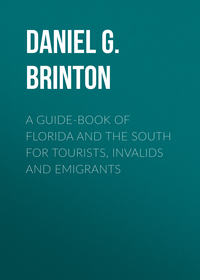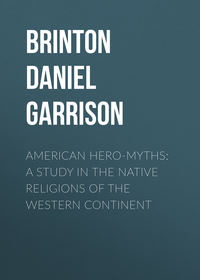 полная версия
полная версияThe American Race
The Payaguas, however, are mentioned distinctly by the early missionaries as a nation with peculiar language and habits. They differed from their neighbors as being aquatic, not equestrian. They were singularly skilful boatmen and had a mythology apart from the other tribes, “worshipping the devil under the figure of a great bird.”509 There is also a manuscript in the Library of the American Philosophical Society, written in the middle of the last century, describing the visit of a missionary to the Payaguas, at that time resident near Santa Fé in Paraguay. He accuses them as given to revolting vices and utterly barbarous.510
The statement of Von Martius that the nation has entirely disappeared is incorrect, as quite recently a vocabulary of it has been obtained by Don Luis de Fontana, which shows it to be distinct both from the Guaycuru and any other known stock.511
LINGUISTIC STOCKS OF THE GRAN CHACOGuaycuru Stock:Abipones, in the central Chaco.
Aguilotes, sub-tribe of the Mbocobis.
Bocobis, see Mbocobis.
Cadioéos, near Fort Olimpo on the Paraguay.
Chichas Orejones.
Churumatas.
Guachis, on Rio Mondego.
Guaycurus, on the middle Paraguay.
Malbalas, on the Rio Vermejo.
Matagayos-Churumatas.
Mbayas, on Rio Xerui.
Mbocobis, on the Rio Vermejo.
Pitilagas, see Yapitalaguas.
Quiniquinaux, northeast of Albuquerque.
Tobas, north of the Mbocobis.
Terenos, on the Rio de Miranda.
Yapitalaguas, on the Rio Vermejo.
Lule Stock:Chunipis, on Rio Vermejo.
Juris, on Rio Salado.
Lules, near Rio Vermejo.
Mataras, on Rio Pilcomayo.
Oristines, on Rio Pilcomayo.
Sinipis, see Chunipis.
Tonocotes, on Rio Pilcomayo.
Toquistines, on Rio Pilcomayo.
Vilelas, north of the Rio Vermejo.
Ysistines, on the Pilcomayo.
Mataco Stock:Agoyas, on Rio Vermejo.
Atalalas, on Rio Vermejo.
Enimagas or Imacos, on east bank of Pilcomayo.
Matacos, on Rio Verde.
Mataguayos, north of Rio Vermejo.
Ocoles, south of Rio Vermejo.
Palomos, on Rio Vermejo.
Taunies, on Rio Vermejo.
Teutas, on Rio Vermejo.
Vejosos, on Rio Vermejo.
Xolotes, on Rio Vermejo.
Yoes, on Rio Vermejo.
Payagua Stock:Agaces, on Rio Paraguay.
Payaguas, near Santa Fé.
Sarigues, on middle Paraguay.
Among the independent Chaco stocks, D’Orbigny classes the Lenguas, who in 1828 lived, about 300 in number, near Corrientes.512 Von Martius believed they were a branch of the Guaycurus.513 There is ample evidence, however, that they were a wandering branch of the Chiquitos of Bolivia. The missionary, J. P. Fernandez, who visited them about a century before D’Orbigny, says expressly that they spoke the same tongue as the Chiquitos;514 and the statement of Hervas that the similarities of their words to the Chiquito arose from borrowed expressions is not well founded.515
The Charruas were a barbarous nation living in the extensive plains which stretch from the banks of the Parana to the sea coast. They were savage and courageous, without fixed homes, and skilled in the use of the bola. One of their customs was to cut off a joint of a finger on the death of a relative, and there were few of the adults that were not thus maimed.516 In appearance they were usually large in size, heavily built, with big heads and broad faces, narrow noses, small eyes and large mouths. Their color was dark.517
The members of this family as recorded by the early writers, especially Hervas, are as follows:
CHARRUA LINGUISTIC STOCKBohanes, on the Paraguay near the Rio Negro (extinct). Chanes, adjacent to the Bohanes. Charruas, on the coast east of the Rio Uruguay. Guenoas, east of the Uruguay. Martidanes, east of the Uruguay. Minuanes, between the Uruguay and Parana. Yaros, on east bank of Uruguay (extinct).
Dr. Paul Ehrenreich describes them as they are to-day, splendid riders and daring soldiers, but faithless and tricky;518 so they have not much improved since Father Chomé in 1730 stigmatized them as francs voleurs de grand chemin.519
The Guatos or Vuatos were accolents of the upper Paraguay and Araguay, and had fixed settlements near Albuquerque. Travelers report them as an unusually handsome people. They are well-built, light in hue, with Roman noses and regular features, and the men with a well-developed beard on lip and chin. This appearance does not belie their intelligence, which is above the average. Polygamy prevails to an uncommon extent. Von Martius thought that they were of a northeastern origin, connected perhaps with the Malalis of Bahia, who are a Tapuya people.520 There may have been some admixture, as from a small vocabulary I quote the following resemblances:

A recent writer does not give so favorable an opinion of this people. He found them living about the junction of the Rio San Lorenzo with the Rio Paraguay, and in a depraved condition. Girls who were not more than five or six years old were used by the men as wives. Sterility and premature decrepitude were the natural consequences.521
On the western border of the Chaco, in the provinces of Tucuman and Catamarca, resided the Calchaquis, a tribe interesting as the only one in the South Atlantic Group who constructed walls of cut stone. At least, such are found in their country, as for instance, one about thirty miles from Andalgala, where there is a well-constructed dry wall about ten feet high, enclosing a space nearly a mile in diameter, evidently once a walled city. Stone built tombs are also frequent, from which the rifler is rewarded with mummies, ornaments of impure gold, and small idols of copper. But I doubt if the Calchaquis developed any such ripe arts as these. History tells us that they voluntarily accepted the rule of the Incas about the middle of the fifteenth century, and that their land became part of the Collasuyu or southern district of the empire. All these remains have a distinct impress of Kechua art, and we may be sure that their inspiration was throughout Peruvian.522
The earliest missionaries depict the Calchaquis with curious usages and with a certain barbaric splendor. A widow became the wife of her husband’s brother, as of old in Israel. So long as she was a virgin, a girl could dress in the gaudiest colors, but once prostrato pudore, as the monk delicately puts it, she must change to sober weeds. Their ornaments were of silver and copper, and the nobles wore a circlet of gold and brilliant feathers. Their seasons of mourning were accompanied with the most violent orgies. Over the dead they raised heaps of stones, and held that the souls became stars.523
We have no specimen of the language of the Calchaquis, although a grammar of it was written by the Jesuit, Alonso de Barcena, and perhaps published. It is called the Katamareño or Cacana tongue, terms derived from the Kechua. The proper names, however, which have been preserved in it indicate that it was different from the Kechua.524 I have already referred (page 227) to Von Tschudi’s suggestion that it survives in the modern Atacameño.
From the few specimens of skulls which have been examined, the Calchaquis appear allied to the Aucanian stock,525 and it may be that further research will prove them a branch of the Araucanians.
The following tribes are mentioned by old writers as members of the
CATAMAREÑA LINGUISTIC STOCKAcalianes.
Cacas or Cacanas.
Calchaquis.
Catamarcas.
Diagitas or Drachitas.
Quilmes.
Tamanos.
The learned Barcena also prepared a grammar of the Natixana or Mogana language, spoken by the Naticas, whom we find mentioned by later authorities as neighbors of the Calchaquis in the government of Santa Fé.526 They apparently belonged among the Chaco tribes. Barcena adds that nine different tongues were spoken in the district of Cordova, among which were the Sanavirona and Indama, which had not been learned by the missionaries.527
2. The Pampeans and Araucanians
South of the Gran Chaco, say from south latitude 35°, begins the true Pampas formation. This, according to the geologist Burmeister, is not a marine deposit, but the result of fluvial overflows and dust storms. It is diluvial and quaternary, and overlies the Patagonian formation, which is marine and early Pleistocene. The pampas are in parts wide grassy plains, like the prairies of the upper Mississippi valley; in parts they are salt deserts, in parts more or less wooded. With little variety, this scenery reaches from the Chaco to the Rio Negro, S. lat. 40°. Nearly the whole of this territory was occupied by one linguistic stock. It is the same which is found in Chili, where its most prominent members are the Araucanians.
Which was the course of migration, whether from the Pacific coast to the Pampean plains or the reverse, is not positively decided, but I am inclined to believe it was the latter. The ancestors of the Araucanians would not willingly have crossed the barren wastes of the desert of Atacama; there are evidences of a different people inhabiting Chili before they possessed it, and we have traces that they had not obtained full possession of that country at its discovery. This view does not deny subsequent migrations of the Araucanians into the Pampas under the pressure of the Spanish invasion.528 In such moving they were simply returning to the traditional homes of their ancestors. As the name of the whole stock, I adopt the word Aucanian, from the Araucanian verb aucani, to be wild, indomitable, from which are derived the tribal names Aucanos and Aucas, occurring on both sides of the Andes.529
The Pampeans are principally nomadic hordes wandering from pasture to pasture with their horses, cattle and sheep. Their transitory encampments, called tolderias, are pitched by the side of some pond or stream. There their low tents made of dried horse skins are grouped confusedly, one to each family. Their food is chiefly horse flesh and mutton, often eaten raw. They raise no vegetables, and dislike agriculture. They carry on, however, many small industries, tan and dye leather, which they work up into boots and horse furniture, and forge with skill iron heads for their long lances, and knives for the chase, while the women trim the ostrich skins into rugs, and weave wool into blankets and ponchos, highly prized for their serviceable qualities.530 These products are bought up by the merchants in the cities, and thus the tribe is supplied with what it most prizes from European markets.
These roving hordes have no particular names. They are referred to as the northern, eastern or western peoples by the Aucanian terms having these significations, Puelches, Moluches, Huiliches. Besides these, there are the Ranqueles on the Rio Quinto, directly west of Buenos Ayres, who are said to have immigrated from Chili,531 and the Querandies, now probably extinct, who once dwelt near that city.
Those living on the eastern slopes of the Andes, about the city of Mendoza, and in the ancient province of Cuyo, are described as taller and stronger than the Araucanians of Chili, and as claiming descent from the Pampean tribes.532 They were locally known as Guarpes, and spoke dialects called the Allentiac and the Milcocayac, not distant from the Pampean proper, concerning which some grammatical description has been preserved.533
Few of the Pampean tribes have been induced to accept civilization or Christianity. They still believe in their good spirit, Chachoa, and in one of evil or misfortune, Gualicho; they continue to obey their priests or medicine men; and the resting places of the dead are regarded with superstitious awe. Marriage among them, while it has the appearance of violence, is really carried out with the consent of the girl and her parents, for a sum agreed upon.
The Molu-Che or Manzaneros are said to be the best of the Pampeans. They are sedentary and have extensive orchards of apples and flocks of sheep to the north of the Rio Limay. They have well-cut features, fresh light complexion, black fine hair, and their women are considered really handsome.534
The Araucanians of Chili, known as singularly bold warriors who defied successfully the Incas, and gave the Spaniards the greatest trouble, occupy the Pacific coast from south latitude 25° to about 43°, and number about 20,000. In physical appearance they resemble the Pampeans, and present marked differences from both the Kechuas of Peru and the Tapuyas of Brazil, having high, brachycephalic skulls,535 and a clear copper color of skin. They are of moderate stature, but muscular, with black hair, round faces, small eyes, and small feet and hands. They are divided locally into northern and southern tribes, but there is little difference in dialects. Their tongue, the Chilidungu, has been extravagantly lauded by some who have studied it, and one worthy missionary was so enamored with it that he published a grammar and dictionary of it in Europe, that it might be introduced as the learned language there, to supersede the Latin:536 it certainly is harmonious and flexible.
The Araucanians did not at any time rise in culture above the level of the Iroquois and Algonquins in the northern continent. It is true that in the tombs in their country we discover fine specimens of pottery, some good work in bronze, gold, copper and silver, and beautiful specimens of polished stone implements.537 But if one examines closely the art-forms of these relics, he can not fail to recognize in them the potent inspiration of the Inca civilization; and we may be sure that if they were not directly booty from that nation, they were the products of its trained workmen, and are not to be put to the credit of Aucanian industry.
AUCANIAN LINGUISTIC STOCKAraucanos, in northern and central Chili.
Aucanos or Aucas, in the central Pampas.
Chauques, in the Archipelago of Chiloe.
Chonos,(?) on Pacific, south of Chiloe.
Cuncos, in Chili, south of Rio Valdivia.
Divie-ches, on Rio Colorado.
Guarpes, near Mendoza.
Huiliches(southern people), tribes to the south.
Moluches (western people or warriors), on Pacific coast.
Pehuenches (pine-forest people), east of Cordillera, north of Rio Colorado.
Picunches (northern people), north of Pehuenches.
Puelches (eastern people), on both banks of Rio Negro.
Querandies, near site of Buenos Ayres.
Ranqueles, between Rio Quarto and Rio Quinto.
The Pacific coast of Patagonia, gashed by ancient glaciers into deep fiords and rocky islands, harbors various tribes whose affinities are uncertain. The most curious of them would seem to be the Chonos or Chunos, or Cuncones. They lived south of the archipelago of Chiloe, and are described as having red hair, a light olive complexion, and of mild and friendly manners. They raised a breed of dogs (perhaps guanacos), and wove their clothing from its coarse long hair.
This account comes to us from as far back as 1619, when the first missionaries visited them,538 and these traits cannot therefore be attributed to intermixture with Europeans. They are not peculiar in these respects. Similar traits are reported of the Boroas, a tribe in one of the valleys of central Chili;539 and I have already referred to the red hair of the boys among the Matacos of the Gran Chaco. Perhaps it was not unusual among these nations, as I can in no other way explain the strange idea of the poet Ercilla the Homer of the Araucanian Conquest, that these people were descendants of the Frisians of North Holland!540
The language of the Chonos is said to be quite different from that of the Araucanians. Pöppig believed it to be a distant dialect of the same stock. Some recent travelers assert that they are now extinct, but Dr. C. Martin informs us that the original inhabitants of the Chonos Islands, who were the “Huaihuenes” Indians, were transported in 1765 to the island of Chaulañec, where their posterity still survive.541
3. The Patagonians and Fuegians
The Patagonians call themselves Chonek or Tzoneca, or Inaken (men, people), and by their Pampean neighbors are referred to as Tehuel-Che, southerners. They do not, however, belong to the Aucanian stock, nor do they resemble the Pampeans physically. They are celebrated for their stature, many of them reaching from six to six feet four inches in height, and built in proportion.542 In color they are a reddish brown, and have aquiline noses and good foreheads. They care little for a sedentary life, and roam the coast as far north as the Rio Negro. They are not without some religious rites, and are accustomed to salute the new moon, and at the beginning of any solemn undertaking to puff the smoke of their pipes to the four cardinal points, just as did the Algonquins and Iroquois.543
Their language differs wholly from the Araucanian, though it has borrowed many words from it. An interesting fact illustrating its stability in spite of their roving life has been brought out by Ramon Lista. He has compared its present form with the vocabulary of it given by Pigafetta in his voyage in 1520, and shows that in the intervening generations it has undergone scarcely any change.544
Von Martius believed that a connection between the Patagonian and the Tapuya stocks could be shown, and gives a tabular comparison of the two.545 I have extended this by means of Ramon Lista’s vocabulary of the former and Dr. Ehrenreich’s corrected forms of the Tapuya, and conclude that the resemblances are illusory, depending on incorrect orthography of the sounds.
About the beginning of the last century the tribes known as Poyas (Pey-yuy) and Reyes (Rey-yuy) were collected at a Mission established on Lake Nahuelhuapi, about south latitude 42°. Hervas reports them as speaking a language radically different from the Araucanian, and probably they should be classed with the Tzonecas.546
On the inhospitable shores of Tierra del Fuego there dwell three nations of diverse stock, but on about the same plane of culture. One of these is the Yahgans or Yapoos, on the Beagle canal; the second is the Onas or Aonik, to the north and east of these; and the third the Alikulufs, to the north and west.
Of these the Yahgans are the best known, through the efforts of the English missionaries who have reduced their language to writing. It is a polysyllabic, agglutinative tongue, with both pre- and suffixes, and is extremely rich in expressions for the ordinary needs of their life. The verb has four numbers, a singular, dual, trial and plural. It does not seem in any way related to the Aucanian stock.547
The tongue of the Onas, who are known as the Yakanna-Cunni, is apparently connected with the Tsoneca or Patagonian, which people they also resemble in stature and physical traits.548
The Fuegians are generally quoted as a people on the lowest round of the ladder of culture; and so they are painted by many observers. They have no government, they can count only to three, ordinary family affection is not observable, and even mothers manifest a lack of love for their offspring. Their shelters are wretched, and they go almost naked in a climate which is both cold and damp.
On the other hand, they display singular ingenuity in their utensils for hunting and fishing; they use the sling, the club, the bow, the bola and the lance; the women weave reed baskets so firmly that they will hold water, and their bark canoes are light and seaworthy.
In hunting they have the service of a native dog which they have trained, and whose welfare they look after with sedulous attention. Though devoid of idols and external rites of worship, they manifest in many ways a sense of religion. Thus the relations of the sexes are surrounded with ceremonies of fasting and bathing, to neglect which would entail misfortunes, and the name of the dead is not pronounced out of superstitious awe. The songs and legends of the Yahgans show some imaginative power. Many of them relate to the marvelous achievements of the national hero, Umoara, who appears to be a wholly mythical individual. Their strongest passion would seem to be for personal adornment, and for this purpose shells, vegetable beads, bright pebbles and variegated feathers, are called into requisition.549
These traits are not those of an enfeebled intellect, and an examination of their physical powers supports a favorable opinion of their capacities. Some of them are unusually tall and strong, especially those on the east coast. Their skulls are mesocephalic and prognathic, and their brains, which have been examined most carefully by a German anatomist, show not a single point of inferiority to the average European brain.550
From examinations which have been carried on in the numerous shell-heaps which line the shores, there is no evidence that any other people ever occupied the islands. Skulls and relics are such as those of the present inhabitants.551 The total number of these is about 8000, nearly equally divided between the tribes named.
The classification of the smaller tribes under the above stocks is not yet complete. So far as I can make it out, it is as follows:
ALIKULUF LINGUISTIC STOCKAlikulufs, on the western end of the Beagle Channel.
Karaikas, south of the Alikulufs.
ONA LINGUISTIC STOCKAoniks or Onas, on Magellan Strait, both shores.
Huemuls, near Skyring and Otway Bays.
Irees, see Pescherees.
Oensmen, see Aoniks.
Pescherees, on central portions of the Strait.
Yacanas, see Aoniks.
YAHGAN LINGUISTIC STOCKKennekas, see Takanikas.
Takanikas, on both shores of the Beagle Channel.
Yahgans, see Yapoos.
Yapoos, on the central Beagle Channel.
The opinion has been advanced by Dr. Deniker of Paris,552 that the Fuegians represent the oldest type or variety of the American race. He believes that at one time this type occupied the whole of South America south of the Amazon, and that the Tapuyas of Brazil and the Fuegians are its surviving members. This interesting theory demands still further evidence before it can be accepted. It is not confirmed by such linguistic comparisons as I have been able to institute.
LINGUISTIC APPENDIX
The linguistic classification of the American tribes is at present imperfect in many regions on account of the incomplete information about their tongues. A proper comparison of languages or dialects includes not merely the vocabulary, but the grammatical forms and the phonetic variations which the vocal elements undergo in passing from one form of speech to another. In some respects, the morphology is more indicative of relationship than the lexicon of tongues; and it is in these grammatical aspects that we are peculiarly poorly off when we approach American dialects. Yet it is also likely that the tendency of late years has been to underestimate the significance of merely lexical analogies. The vocabulary, after all, must be our main stand-by in such an undertaking.
For that reason I have thought it worth while to bring together a short list of common words and show their renderings in a number of American tongues. Inasmuch as the languages north of Mexico—those in the United States and Canada—have been frequently studied and are readily accessible in published books, I have confined my specimens to the tongues of the central and southern regions of the continent.











